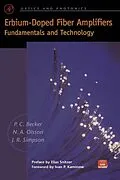Erbium Fiber Amplifiers is a comprehensive introduction to the increasingly important topic of optical amplification. Written by three Bell Labs pioneers, the book stresses the importance of the interrelation of materials properties, optical properties, and systems aspects of optical fiber amplifiers. All disc-based content for this title is now available on the Web. Key Features* Explains the theory of noise in optically amplified systems in an intuitive way* The book contains a discussion of components used in amplifier fabrication and of the attendant technologies used in real systems* The book provides basic tools for amplifier design as well as systems engineering, including the latest developments in WDM and soliton systems* The book discusses the fundamentals of rare earth ions for the reader desiring more depth in the topic* The book is for either the novice of experienced reader* The chapter have links between them to allow the reader to understand the relationship between the amplifier characteristics, noise, and systems applications* The book contains extensive references
Autorentext
After doing his Ph.D. thesis on the luminescent properties of thulium at UC Berkeley, Philippe joined Bell Laboratories in 1986 where he contributed to the development of erbium doped fiber amplifiers. He has also done extensive research in the femtosecond laser field, and was a member of the Bell Labs research group which generated the world record shortest laser pulse. He was awarded the 1994 NASTS award for his contributions to the development of the erbium fiber amplifier. He is a member of the OSA and the IEEE. After a recent stint directing strategy for Lucent Technologies corporate strategy group, Philippe is now Business and Marketing Director for Lucent Technologies Advanced Lightwave Systems.
Klappentext
Erbium Fiber Amplifiers is a comprehensive introduction to the increasingly important topic of optical amplification. Written by three Bell Labs pioneers, the book stresses the importance of the interrelation of materials properties, optical properties, and systems aspects of optical fiber amplifiers.
All disc-based content for this title is now available on the Web.
Key Features* Explains the theory of noise in optically amplified systems in an intuitive way
* The book contains a discussion of components used in amplifier fabrication and of the attendant technologies used in real systems
* The book provides basic tools for amplifier design as well as systems engineering, including the latest developments in WDM and soliton systems
* The book discusses the fundamentals of rare earth ions for the reader desiring more depth in the topic
* The book is for either the novice of experienced reader
* The chapter have links between them to allow the reader to understand the relationship between the amplifier characteristics, noise, and systems applications
* The book contains extensive references
Inhalt
INTRODUCTION
1.1 Long Haul Fiber Networks
1.2 Historical Development of Erbium-Doped Fiber Amplifiers
1.3 From Glass to Systems
2 OPTICAL FIBER FABRICATION
2.1 Introduction
2.2 Conventional Communication Fiber
2.3 Rare Earth Doped Fibers
2.4 Pump-Signal Interaction Methods
2.5 Compositions
2.6 Physical Properties
3 COMPONENTS AND INTEGRATION
3.1 Introduction
3.2 Fiber Connectors
3.3 Fusion Splicing
3.4 Pump and Signal Combiners
3.5 Isolators
3.6 Circulators
3.7 Filters
3.8 Fiber Gratings
3.9 Signal Multiplexers and Demultiplexers
3.10 Signal Add/Drop Components
3.11 Dispersion Compensation Components
3.12 Integrated Components
3.13 Pump Lasers
4 RARE EARTH IONS--INTRODUCTORY SURVEY
4.1 Introduction
4.2 Atomic Physics of the Rare Earths
4.3 Optical Spectra of Rare Earth Ions
4.4 Fundamental Properties
4.5 Spectroscopy of the Er3 Ion
4.6 Er3 -Er3 Interaction Effects
5 ERBIUM-DOPED FIBER AMPLIFIERS--AMPLIFIER BASICS
5.1 Introduction
5.2 Amplification in Three-Level Systems
5.3 Reduction of the Three-Level System to the Two-Level System
5.4 Amplified Spontaneous Emission
5.5 Analytical Solutions to the Two-Level System
6 ERBIUM-DOPED FIBER AMPLIFIERS--MODELING AND COMPLEX EFFECTS
6.1 Introduction
6.2 Absorption and Emission Cross Sections
6.3 Gain and ASE Modeling
6.4 Amplifier Simulations
6.5 Transverse Mode Models--Erbium Confinement Effect
6.6 Excited State Absorption Effects
6.7 Er3 -Er3 Interaction Effects
7 OPTICAL AMPLIFIERS IN FIBER OPTIC COMMUNICATION SYSTEMS--THEORY
7.1 Introduction
7.2 Optical Noise: Device Aspects
7.3 Optical Noise: System Aspects
8 AMPLIFIER CHARACTERIZATION AND DESIGN ISSUES
8.1 Introduction
8.2 Basic Amplifier Measurement Techniques
8.3 Amplifier Design Issues
9 SYSTEM IMPLEMENTATIONS OF AMPLIFIERS
9.1 Introduction
9.2 System Demonstrations and Issues
9.3 Soliton Systems
10 FOUR LEVEL FIBER AMPLIFIERS FOR 13 MM AMPLIFICATION
10.1 Introduction
10.2 Pr3 -doped Fiber Amplifiers
10.3 Nd3 -doped Fiber Amplifiers
Appendix
Subject Index
